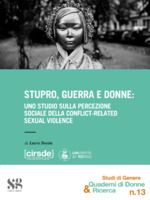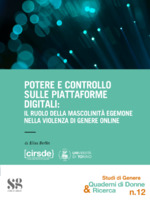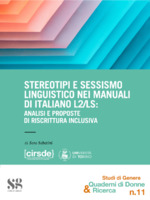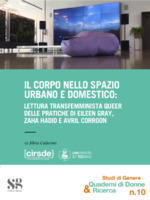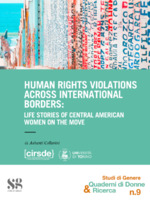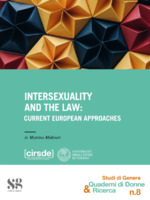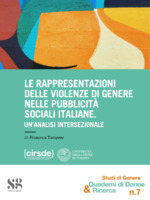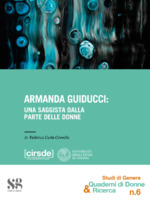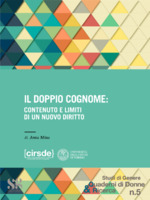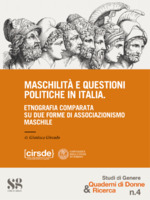Sfoglia documenti (27 in totale)
- Collezione: CIRSDe
Sort by:
Stupro, guerra e donne: uno studio sulla percezione sociale della conflict-related sexual violence
War has been, and still is, highly characterized by sexual violence. The present work takes a cue from the testimonies of victims of Conflict-Related Sexual Violence narrated by Lamb (2020) in “Our Bodies, Their Battlefield: What war does to Women” since, as the author writes, “You won’t find these women’s names in the history books or on the war memorials that we pass in our railway stations and town centres but to me, they are the real heroes.” (p.11).
Although war rape has existed for as long as conflicts themselves have existed, the legislative relevance of this crime as a crime against humanity, as a weapon of genocide, and as a war crime, only came into existence following the establishment of ad hoc international criminal tribunals for the former Yugoslavia and Rwanda.
Understanding the origin of sexual violence in armed conflicts is very complex as it is the result of multiple variables: from cultural norms to complex political and war strategies. Rape is often committed to terrorizing the population, breaking up families, destroying communities and even changing the ethnic composition of the next generations.
Many studies have focused on the socio-political analysis of this reality and the consequences at individual, social, and community levels. Few, however, have investigated the social perception of this issue. The main purpose of this exploratory research is to investigate whether people's perception of sexual violence can be influenced and modified by the war context in which this violence occurs, since, as Frese and colleagues (2004) point out, the characteristics of the context in which the violence occurred influence the participant’s perception of the event. In particular, the focus was on the recognition of the event as violence, the perception of severity, and the punitiveness of the perpetrators.
Potere e controllo sulle piattaforme digitali: il ruolo della mascolinità egemone nella violenza di genere online
This essay aims to investigate, through an analysis of the literature and the presentation of an experimental study, the main psycho-social risk factors underlying online gender-based violence, together with the way in which this form of abuse is perceived by the population.
The first chapter offers an overview of the main psychological, emotional and relational dynamics underlying gender-based discrimination and abuse (online or offline), together with the analysis of some behavioural practices frequently carried out in the context of the so-called “homosocial relationships” (Bird, 1996).
The second chapter of this work specifically addresses the presentation of the aforementioned environments. In this regard, the illicit production of sexually explicit material, the use of photo-editing techniques within a pornographic frame (deepfake-porn) and the submission of one's own genitals' photos without the recipient's consent (cyberflashing) represent some of the online gender-based form of abuse most frequently carried out, together with the non-consensual dissemination of intimate images. The last part of the second chapter presents the so-called “manosphere”, a virtual network made up of blogs, forums and online groups explicitly dedicated to the establishment of homosocial relationships based on nostalgia for the traditional patriarchal values.
The third chapter addresses the prevention of online gender-based violence. Since the introjection of sexist beliefs and gender stereotypes begins in early childhood, offering young people non-stereotyped grafic, linguistic and media representations is crucial, as well as addressing topics such as gender, affectivity and non-judgmental sexuality in primary and secondary school. On the other hand, an equally important role belongs to the media system, due to its ability to promote social norms introjection by the population (Cialdini and Trost, 1998).
Finally, the fourth chapter offers a brief presentation of this experimental research project. The study highlighted a strong relationship between individual levels of sexism, sexual double standard and right wing authoritarianism and, on the other side, people's ability (or inability) to feel empathy towards victims of online gender-based violence, emphasazing the need to address these variables in order to prevent the diffusion of the phenomenon.
Stereotipi e sessismo linguistico nei manuali di italiano L2/LS: analisi e proposte di riscrittura inclusiva
The work aims at a reconnaissance of the current teaching material used in classes of Italian as a foreign language, bearing in mind the perspective of gender inclusive language and gender stereotypes.
A detailed linguistic analysis of copiuous textbooks – which was carried out upholding the approach of Italian linguist Alma Sabatini - highlights how the female world is still shaped through a male-dominant point of view. As a matter of fact, linguistich inclusivity often fails to be achieved, falling the Italian language into the grammatical gender languages type. The purpose of the analysis present in Chapter 3 is to show how a gender sensitive linguistic approach can be obtained and integrated into foreing language teaching material of Italian language, catering to all six level of the CEFR (Common European Framework of Reference for Languages) through degendering and engendering strategies.
On the other hand, the ambition of shaping multicultural beings across the world calls for the analysis of the socio-cultural aspects representing Italy in the aforementioned textbooks. This analysis (Chapter 4) recognizes five areas in which gender stereotypes, regarding the female sphere, are strongly pervasive and fail to represent the actual nuaces of life and personal identity - childhood, labour, family care, housekeeping, and physical appearence.
Lastly, Chapter 5 argues the outcomes of both the linguistic and socio-culultural analysis, in view of a future improvement of such teaching materials.
Il corpo nello spazio urbano e domestico: lettura transfemminista queer delle pratiche di Eileen Gray, Zaha Hadid e Avril Corroon
This essay aims to carry out, through a queer transfeminist methodology, an analysis of the built environment and architectural spaces, with reference to the work of Eileen Gray, Zaha Hadid and Avril Corroon.
In the introduction, the key terms of the paper will be defined, including transfeminism and queer studies. In summary, transfeminism refers to an intersectional feminist methodology that, in its analysis, considers, in addition to sexism, several axes of oppression, such as racism, classism, ableism, sexual orientation - and embraces the struggles of trans people (Filo Sottile 2020). Queer studies, on the other hand, refers to the study of issues involving gender identity and sexual orientation, questioning both the naturalness of the binary division of gender into male and female, as well as that of sexual orientation (Arfini 2020), demonstrating how gender identities are constructed within a set of behaviours, actions, beliefs, and stereotypes that are repeated through a system called gender performativity (Butler 1999). Queer transfeminism has, among its aims, to unhinge a binary system of power through the intersection of feminist and sexual liberation issues with struggles that relate to classism, racism, and ableism, to create an alliance between all subjectivities different from the norm, to achieve social justice.
The first chapter of this paper questions the role of the body in space, examining various urban and architectural structures. The theme of the heterosexual and ableist matrix as prerequisites for understanding our built environment (Wajcman 1991), i.e., the space that bodies relate to, is explored, illustrating the concept of performativity of gender and deviance introduced by Judith Butler (Butler 1999). The theme of the body in architectural design is addressed (Bianchetti 2020), and we finally focus on the issues of housing rights and dispossession, as well as that of social and housing justice (Butler, Athaniasiou 2019).
The second chapter examines the language of gender, analysing language and its constructive and imaginary potential. The role of gendered language in architecture is also analysed, and proposals are shown that can go beyond the limits that our language imposes.
Furthermore, how the mass media have represented bodies in space is explored, and specifically, the photographic material of Le Corbusier's works (Colomina 1992, 1994) and that of Hugh Hefner's Playboy fashion house (Preciado 2020) are analysed.
In the third, fourth and fifth chapters, the work of three female artists is explored: the work of Eileen Gray is examined, looking in particular at E.1027, the house that the designer-architect realised in France, according to a queer reading of the architectural project; Zaha Hadid's practice is read from a transfeminist perspective, and in particular through Donna Haraway's cyborg myth; the work of Avril Corroon, a contemporary Irish visual artist, is analysed, whose practice questions the housing emergency in the contemporary neoliberal market.
Human rights violations across international borders: life stories of Central American women on the move
The essay documents and analyses the topic of violence in Central American migration, with a specific focus on migrant women in the current mobility regime South-North. We start by tracing the conditions that push women to undertake the migratory path in their countries of origin, more specifically in the Northern Triangle countries, that include Honduras, El Salvador and Guatemala; we then analyze the moment of transit, in order to highlight some of the great challenges that women incur in their path towards the destination country, being it Mexico or the United States; lastly, we shed light on the border-crossing experience and on some life stories in the context of arrival. Through this work we aim at demonstrating that the journey of Central American women is shaped by different forms of violence in every step of migration, and how the mobility and border regime is strongly compromised by the lack of application of a human rights approach. The personal contribution to this work is given by a fieldwork realized through eight qualitative interviews with experts in the field.
Intersexuality and the Law: Current European Approaches
This essay focuses on the complex relationship between intersexuality and the law. It aims to highlight the issues that are emerging in European legal systems due to the lack of specific measures or legislation regarding gender identity, and the ad hoc legislation which does exist but fails to distinguish transsexualism from intersexuality.
The most pressing issue that the law should tackle is the performance of unnecessary, irreversible, and invasive surgery on intersex children. Indeed, most of European Member States do not explicitly legally ban this practice.
First, international and European Union law is considered noting that they do not provide for any legally binding instrument for the protection and recognition of intersex human right. However, in recent years they have shown to be progressively responsive towards intersex individuals.
Then, three legislative models are identified and the national legal frameworks corresponding to them analysed. The first, adopted by Germany and Austria, is based on the introduction of a third sex. The second is contained in Belgian legislation, and establishes the self-determination principle, which permits the choice of a preferred gender on identity documents, without particular requirements being met. The third approach has been adopted only by Malta so far. It is characterised by multiple measures and, accordingly, it is more systemic and holistic. In fact, the Maltese legislation explicitly recognises the intersex condition, and it conceives sex as a spectrum, thus going beyond gender binarism. Moreover, it prohibits discrimination based on sex characteristics, establishes the self-determination principle, and it bans irreversible, unnecessary, and aesthetic surgery from being carried out on intersex people.
Lastly, theoretical analysis on the role the law should play in tackling intersex issues is presented. Alongside, some factual cases of human rights violations on intersex people a way forward is proposed, considering the most interesting proposals and insights from the intersex community.
Le rappresentazioni delle violenze di genere nelle pubblicità sociali italiane. Un’analisi intersezionale
According to the literature (Oddone 2013; Ciccone 2014; Cosenza 2015; Magaraggia 2015; Polizzi & Oliveri 2015), the representations of gender-based violence in Italian social advertisements are strongly linked to stereotypical imaginaries of the physical dimension, domestic violence, and the removal of victims' agency, as well as heteronormative and ableist ones. In my qualitative research on 12 advertisements (from 2006 to 2019), I tried to identify representations that go beyond hegemonic terms, with particular attention to the dimensions of racism, ableism and homolesbobitransphobia, applying the intersectional approach, to reacha more complex understanding of how identities and power relations are constructed in visual media. My analysis sought to answer the question of whether social advertisements contain images that challenge stereotypes and prejudices regarding violences, or whether they reiterate certain representational mechanisms that are the result of the phenomenon they are intended to combat. The hypotheses on their verifiability ‒ and therefore on the scarce capacity to challenge the preconceptions of those advertisements that by their function should promote social change ‒ were tested on the basis of the following variables, according to a qualitative methodology that refers to socio-semiotic visual analysis in search of counter-hegemonic narratives: promoting subjects, ways of representing the places of violence, representation of the violences themselves, identities and bodies and communicative style. My research shows that, in Italy, it is difficult to carry out campaigns against gender violence that exclude or question stereotypes. On the one hand, there is a gap between innovative aims and the use of stereotypical language, which is typical of social advertising’s form. On the other hand, there are considerable differences between the various promoters: there is a tension between the different structures and aims of the promoters surveyed, between public service advertising and advocacy.
Armanda Guiducci: una saggista dalla parte delle donne
The work outlines the profile of Armanda Guiducci (Naples 1923 - Milan1992): philosopher, anthropologist, writer and literary critic. Through various archive researches the author's literary biography has been reconstructed, which returns the image of an eclectic writer, with composite intellectual activity and a wide and varied production. At the same time the work studies seven essays by Guiducci on the condition of women which, although they share a purely anthropological approach, belong to different genres. Therefore, underlining analogies and differences, the thesis highlights how each of them declines certain themes, as the point of view assumed by the author and the use of some common stylistic traits; with the aim of providing an even more detailed profile.
Il doppio cognome: contenuto e limiti di un nuovo diritto
The work aims to analyze the current legislation on the transmission of the surname to the children in the Italian legal system, to verify if this rule respects the principle of equality between the parents and the principle of the protection of the child's personal identity.
The rule of automatic transmission of the father's surname was indeed a glaring symbol of discrimination between parents, which reflected a deep-rooted background of inequality between men and women that can still be seen today.
The decision of the Corte Costituzionale n. 286/2016 stated that parents can give their child the surname of the father, followed by the surname of the mother if both are in agreement. Nevertheless, there are issues that a jurisprudential decision, even if crucial for the matter, cannot resolve. In fact, the judgment doesn't solve the question of the accumulation of surnames in future generations, and doesn't decide whether the children of the same family should have the same surname.
After a careful analysis of the issues that currently remained unresolved, hypotheses will be formulated to find solutions that are both respectful of the right of equality between parents and of the personal right of the child to have both branches of his family recognized in his surname. Lastly, the answers obtained from the interviews regarding the matter of the "double surname", in which several Italian municipalities participated, will be examined and will be subject to reflection.
Maschilità e questioni politiche in Italia. Etnografia comparata su due forme di associazionismo maschile
This thesis displays an ethnographic research aimed at the exploration of the «politics of masculinity», which represent a phenomenon of «mobilizations and struggles where the meaning of masculine gender is at issue, and, with it, men’s position in gender relations» (Connell, 1996, 205). Given the shortage of academic and public debate, which historically concerns the themes of masculinity, the research focuses on the concept of crisis and its spread. In addition to its contribution to the growth of media interest and to the development of men’s studies in recent years, this notion has fostered the diffusion of the male voice in the shape of specific associations. This thesis takes into account two Italian experiences that are significant for their theoretical contrast about men’s studies. Bounded up with the social constructionism, Maschile in gioco (Rome) is a group that practises self-consciousness and belongs to the network of Maschile Plurale association, whereas Campo maschile (Brescia) is configured as a project in continuity with the Maschi Selvatici association and with its typically «essentialist» positions. From a methodological point of view, the participant observation – a functional technique for the investigation of form and content of the two case studies – is accompanied by the technique of «focused interview». These qualitative techniques are useful for studying experiences of which literature has already highlighted the contrast in terms of discursive repertoires: in the first case they are aimed at the deconstruction of masculinity, in the second at its reconstruction. However, by enhancing the «continuity» between content and form, the research lays particular stress on a common – even though oriented towards opposite directions – work, which involves the two case studies as all-male socialization agencies. In the end, the research emphasizes the recurrence of a model of masculinity close to intimacy – not far from the concept of «caring masculinities» (Elliott, 2015) – which unites the two case studies and is able, perhaps, to challenge the deep-rooted patriarchal system of our society.

